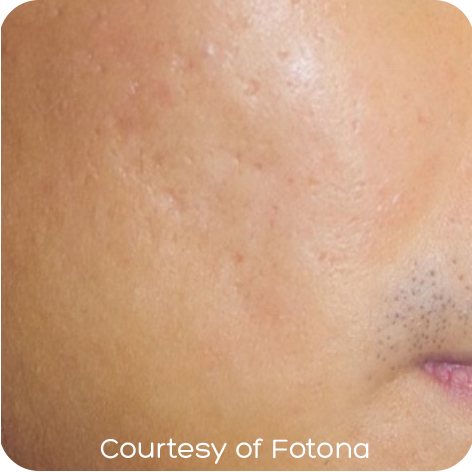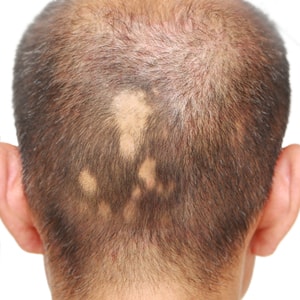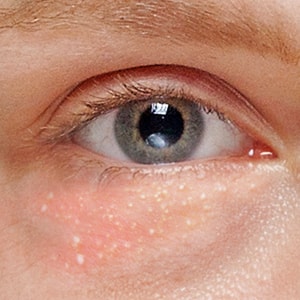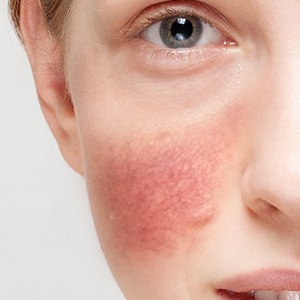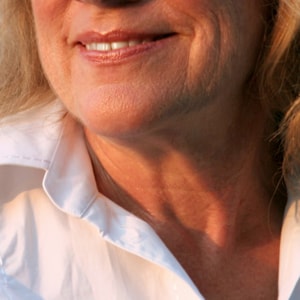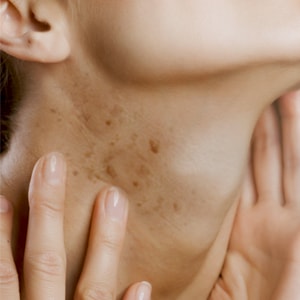Laser treatment for Acne Scars at rtwskin clinic
Acne Scarring and Scar reduction in Tunbridge Wells, Kent and Sussex
 Scarring usually follows deep-seated inflammatory acne spots, but may also occur as a result of more superficial inflamed lesions in scar-prone patients. Scars may show increased collagen (hypertrophic and keloid scars) or be associated with collagen loss (depressed or atrophic scars). Acne scarring may come in different degrees and types: pitted, shallow, rolling, atrophic, boxcar. For patients who suffer with severe acne, our Doctors usually prescribe antibiotics, Obagi topical products with a course of chemical peels or strong medication like Roaccutane. Neglect to treat patients with severe acne effectively and at an early stage usually results in scarring. It is best to treat scars when they are still fresh and have not matured, as they are more stubborn and more difficult to treat later on.
Scarring usually follows deep-seated inflammatory acne spots, but may also occur as a result of more superficial inflamed lesions in scar-prone patients. Scars may show increased collagen (hypertrophic and keloid scars) or be associated with collagen loss (depressed or atrophic scars). Acne scarring may come in different degrees and types: pitted, shallow, rolling, atrophic, boxcar. For patients who suffer with severe acne, our Doctors usually prescribe antibiotics, Obagi topical products with a course of chemical peels or strong medication like Roaccutane. Neglect to treat patients with severe acne effectively and at an early stage usually results in scarring. It is best to treat scars when they are still fresh and have not matured, as they are more stubborn and more difficult to treat later on.
At Cobden House Medical Centre we offer several treatment options for different types of acne scars. Procedures include laser resurfacing, fractional RF microneedling steroid injections, topical products, dermal filler injections and LED light treatments to aid healing.
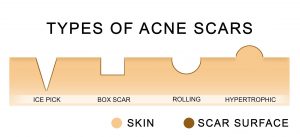
Textured acne scar can be treated with laser resurfacing (CO2 or Erbium), fractional RF microneedling, steroid injections and dermal filler injections.
Smaller and deeper pin point, ice pick and boxcar scars can be treated with ablative fractional laser resurfacing and fractional RF microneedling.
Raised or bumpy acne scars can be treated with steroid injections.
Wider rolling (depressed) acne scars can be treated with hyaluronic acid based products such as Juvederm.
Brown acne scars, associated with darker skin types can be treated with bleaching products such as hydroquinone and Q-switched laser.
Red acne scars, typically seen in lighter skin types can be effectively treated with Nd:Yag laser.
Different types of scarring may be present and will respond better to different types of treatment. Therefore, it is common for an individual to need a combination of treatments or procedures. Most acne scar conditions can be corrected or minimised permanently if treated quickly and efficiently with the right treatment and product.
At rtwskin, we only use treatments that we believe work and your concerns are addressed in line with your budget and your desired results. We can help to improve your acne scars safely and effectively with our wide range of laser treatments and advanced medical skincare.
To find out which option is right for your acne scar treatment, please book your appointment to see our Consultant Dermatologist or our Speciality Doctor in Dermatology. Each condition will vary in the total number of treatments required and the time it takes to reach the desired effect.
Treatment options for acne scars:
- CO2 Fractional Laser Resurfacing. The DEKA SmartXide2 CO2 Laser & RF System will treat only a fraction of the skin at a time. The Laser will remove the scar tissue by drilling many minuscular holes (thinner than human hair) deep into the dermis and simultaneously deliver heat to shrink and close these tiny holes. Moreover, CO2 Laser light will contract old collagen in the skin and the wound healing process will stimulate new collagen production, thereby bringing improvements to the skin tone and texture which will continue for 3-6 months after the procedure. Result is gradual and requires several treatments.
- Skin Surgery. Using a minor procedure called punch excision, our Dermatologist will cut out individual acne scars and repair the holes at the scar sites with stitches.
- Dermaroller – Collagen Induction Therapy. Skin needling with a dermaroller produces hundreds of tiny dermal injuries. Each dermal injury triggers the normal healing response within the skin. Successive treatments build new collagen progressively and this will gradually fill in depressed scars.
- RF Microneedling. The micro-needles are driven directly into the skin at a certain depth (0.2mm-3.0mm) and radiofrequency (RF) energy is then released inside of the skin. Minimally invasive RF thermal energy creates fractional electrocoagulation in the dermis which facilitates a natural wound healing process (WHP).WHP promotes the remodelling of collagen. This procedure not only stimulates dermal remodelling but RF also inhibits sebaceous gland activity which will improve active acne and acne scars.
- Dermal Fillers. Injecting Dermal Fillers under the skin and into indented scars can fill out or stretch the skin which makes the scars less noticeable. Results usually last up to 1 year. Side effects include temporary swelling, redness and bruising.
- Chemical Peels. TCA, Obagi Blue Peel, ZO Control Depth Peel.
- Radiofrequency Treatments: DEKA Triactive+ and Indiba use heat energy to reduce sebum production, stimulate collagen and circulation in the skin. This will all help to improve acne scarring and maintain acne remission.
- All laser procedures will require a test patch a minimum of 24 hours prior to treatment. This is a standard requirement for safety and insurance purposes.
CHECK OUT OUR  TO READ MORE ABOUT ACNE SCARRING
TO READ MORE ABOUT ACNE SCARRING
Depending of the depth of your acne scaring and the result you want, we may suggest combining a number of options including CO2 Laser skin resurfacing or medical dermal roller treatments to help stimulate your collagen which renews your skin. The number of CO2 Laser skin resurfacing treatments or medical dermaroller will vary from person to person, but typically one to three treatments will give you the fresh-faced, look you’re after!
Take a look at our price list and you’ll get an idea of the range. Don’t forget you can join our loyalty scheme and save money on regular treatments, so that’s a lovely bonus. We will be open and honest about prices when we meet for a chat at the very first consultation, so that you can make your decision in your own time. And the consultation is free. So drop us a line or give us a call to come in for a chat.
There’s very minimal discomfort during the procedure and we like to use an aesthetic cream for good measure! Immediately after the treatment you may look a bit pink and feel a slight sting. Your skin will feel tighter too, but that’s not a bad thing! In general, the areas are healed in 10 to 21 days. We recommend you use sunscreen and hydrate your skin with moisturiser. The treatment is less suitable for people with darker skin tones who have a greater risk of pigmentation changes.
The IPL treatment shouldn’t cause much discomfort. You may feel a slight tingling as the consultant passes the hand held laser and across the treatment area. It’s been described as a warm day on the beach. Any redness or inflammation should only last a day or two after the treatment. Aloe Vera gel is helpful and should be used regularly at home after treatments to soothe the area. You’ll need to be careful to protect the area from sunshine during the treatment period, so keep it covered up whatever the weather or use an SPF30 sun protection cream.
There are many different types of lasers used in the treatment of acne scars. Three types of lasers used to improve or eliminate acne scars: Erbium or CO2 lasers (textured acne scars), Nd:Yag laser (red acne scars) and Q-switched laser (pigmented acne scar).
Resurfacing CO2 and Erbium lasers are commonly used for treating textured acne scars. These lasers are designed to resurface the skin and remove enough of the surface layer reach the tissue below the scar. When the tissue regenerates, it is smoother and more pliable without the memory of the acne scar. Although it is difficult to get rid of textured acne scars altogether, they can be greatly improved. Improvement depends on the depth of the scars, age of the scars, and the amount of treatments

